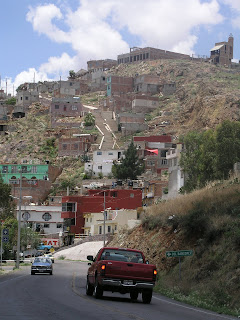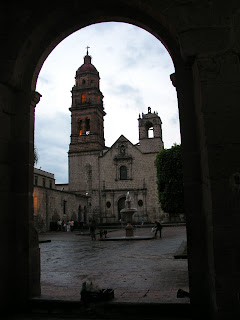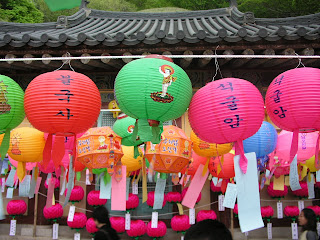Teotihuacan is one of the greatest archeological sites in North America. The main Pyramid of the Sun is the third largest pyramid in the world. And it's all just a few hours flight from the United States. Oddly enough, you don't see that many Americans there.
Entering the site
The Pyramid of the Sun
The Pyramid of the Moon
Looking down the Avenue of the Dead from the Pyramid of the Moon
Monday, August 3, 2009
Teotihuacan
Thursday, July 30, 2009
Guanajato
This was my second time to Guanajuato, and it remains one of my favorite places to visit. The town was built on the backs of the silver mines. Two main streets run down the bottom of the valley, with sidewalks stretching up the sides of the hills. The main streets are a little narrow and frequently choked with vehicles, but once you get away and head up the sidewalks there are endless opportunities to explore.
A couple of views of houses built up the side of the valley.
A view of El Callejón del Beso
From the top of the same alley
Another alley in Guanjuato
A must see is a Callejoneada. Basically a late night party on the go, you follow a small troupe of musicians around the alleys and streets. To find one, just head out around 8 or 9 and listen for the music. Join the crowd and enjoy the music. They sometimes pass out small shots of tequila or other liquor, but you'd be better off BYOB.
The one thing to avoid is the mummy museum. It's basically a lot of this. Not worth the pesos or the crowds.
Tuesday, July 28, 2009
La Quemada
Near Zacatecas is la Quemeda, the ruins of a Mesoamerican village. It's not as impressive as Teotihuacan, but it's still a nice place to visit. The ruins are built into a hill.
A closer look
A small pyramid.
On the way back we got hit by a torrential down pore that caused a little flash flood. It was a little scary since we were surrounded by fields with no high ground to evacuate to. What appeared to be giant cakes of salt were floating by our van.
Monday, July 27, 2009
Zacatecas
Zacatecas was one of our favorite places. Like Gunajuato, it is an old colonial town that made a fortune from silver. Hotel prices are a bit higher than elsewhere, but it's well worth a couple nights stay. There are several good museums in town, and plenty of places to stroll around and check out the views.
The Cerro de La Bufa, which serves as a major landmark in town. There's a road leading to the top, but the hike up is worthwhile. Just don't forget to bring water.
One of the hills in Zecatacas
Looking down on the city center
A view of the cathedral and the cerro de la bufa
There's a old silver mine that you can tour. The price is kind of high. I think it was around 150 pesos a person. But it was an interesting tour. There's also a nightclub in the mine, but we didn't go, so I don't know what the prices are like.
We caught the International Folk Dance Festival. The streets were a little crowded, but it really livened up the town.
Some of the folk dancers performing.
Friday, July 24, 2009
Guadalajara
Thursday, July 23, 2009
Tequila
From Guadalajara we took a day trip out to Tequila, the home of tequila. Tours run about 100 Pesos (8 or so dollars), and they all seem to be about the same. See the distillation plant, see the aging kegs, and have a few shots. You might also get to see the blue aguave fields used to make the liquor. In my opinion, the tours aren't really worth it. It's a nice little town, which is well worth visiting, but don't bother with a tour. Just head to a local cantina had have a few shots. And pick up a bottle at one of the many liquor stores in town.
The tour buses lined up
Blue aguave and the steamer they cook them in
The wort which is fermenting
Storage vats
One of the many tequila liquor stores in town
Thursday, July 16, 2009
New York City
A quick stop in New York City on the way to Mexico. On the afternoon of our arrival, we visited the Guggenheim, took a stroll through Central Park and saw Times Square. The next morning we took the Statue of Liberty Crown Tour and strolled around downtown Manhattan before heading to the airport. The Crown Tour is highly, highly recommended. Not just because it's cool to go up into the crown, but because you get to bypass the humongous lines that go into the base.
Sunday, May 10, 2009
The neighborhood II
It was a nice today, so I decided to get some exercise and do some hiking in the mountains around my house. I'm mapping the trails so that I don't get too lost. Here is the route I took. My house is #17 on the map. 
Since my GPS records elevation, I thought I'd include that as well.
At #26 I discovered what appears to be a helicopter pad. Or maybe it's just a slab of concrete on top of a mountain. From the growth around it, it seems to have been abandoned some time ago.
Not far from the slab of concrete is a grave site. There are graves scattered all over the place around here, but most are much lower lying. Over Chuseok (the Korean Thanksgiving) families will usually visit the graves of their ancestors and have a small ceremony. I'm not sure if people still visit this one, but it is a reasonably vigorous hike up there. I even saw another grave site on the next mountain over. It would be at least a 2 or 3 hour hike from any village in the area.
My next finding was one of the electrical towers that carry power lines over the mountains. #27 on the map, for those keeping score at home. There's actually a dirt road that led up to this tower. The second structure on your left holds a cable that I presume was used to transport supplies to the next tower over, which isn't connected to the road.
Taking the dirt road, I heard some noise. I uncovered a group of workers assembling another tower. They were rather surprised to so me.
Working on the high steel.
The view from the tower. Most of the time the trees block the view, so it was good to get a glimpse of everything from up high.
The tower from further away.
Sunday, May 3, 2009
Buddha's Birthday in Gyeongju
Buddha's birthday rolled around again, and as tradition dictates, I visited three temples.
Bunhwangsa
First was Bunhwangsa. It dates from the 7th century, although it has been reconstructed a couple of times. The pagoda is a reconstruction of one of the first pagodas built in Korea. Overall, it's a rather small temple, but it's near several other famous sites.
From Bunhwangsa we attempted to take the bus to Bulguksa. After waiting for about 15 minutes, the other people waiting at the bus stop told us they had been waiting for an hour. So we started walking toward the bus terminal in town. About half way there we saw buses headed to Bulguksa. So we grabbed a bus from there.
Traffic on the road leading to Seokguram/Bulguksa.
Seokguram
Seokguram Grotto is a UNESCO World Heritage Site. The Grotto itself is a temple that's been buried under a mound, much similar to the burial mounds throughout town. Inside are sculptures of Buddha and various other apparitions. Buddha's Birthday is the one time of the year (although maybe on Lunar New Year's Day as well) that you can go inside and walk around the Buddha. On the list of World Heritage Sites that I've visited, I wouldn't rank this one very high.
The outside of the Grotto.
Bulguksa
The final stop was Bulguksa, which is probably the most famous temple in Gyeongju. It's not a particularly impressive temple, but on the night of Buddha's Birthday it does have a bit of charm. Unfortunately, it started to rain so the crowd thinned out and the lantern parade around the pagoda was reduced to a few hardy souls. I still managed to get a few decent photos of the temple and lanterns, so I was happy.















































